The Life And Times Of A. Lange & Söhne Re-Founder Walter Lange
On January 17, 2017 the sad news did not take long to get around the halls of Geneva’s Palexpo, where the SIHH was being held, that Walter Lange had passed away earlier that morning.

Walter Lange at the 2015 edition of the SIHH
That very evening the annual “Lange Friends” dinner took place, a yearly celebration A. Lange & Söhne puts on for what I like to call the “Lange family,” a group of owners, collectors, and journalists, who are particularly passionate about the brand. At the 2016 dinner, I sat right next to Walter Lange, as I’ve done on so many occasions, listening attentively to him talk about the old times, soaking in as much as I possibly could.
This year, only the ghost of Walter Lange accompanied us on this special night in Geneva, for he was there as much as any person could be who isn’t physically in a room: in a moving talk, A. Lange & Söhne CEO Wilhelm Schmid encouraged us to tell each other stories about Walter Lange, and that is exactly what every table ended up doing. Needless to say, the dinner ran quite a bit longer than it usually does.

Tribute to Walter Lange at the A. Lange & Söhne booth at SIHH 2017
While this is certainly not the place for all those personal stories, I would indeed like share a few anecdotes about what this gentle giant in the world of fine watchmaking accomplished in his 92 years on this planet.
And to do that, I have to back up a little and briefly talk about Walter Lange’s great-grandfather, Ferdinand Adolph Lange, as well as some of the history of Glashütte and A. Lange & Söhne. This is important for us to understand where Walter Lange came from.
A short visit to Dresden and surroundings of the 1800s
F.A. Lange, born in 1815, was a central figure in the history of German watchmaking. A watchmaker to the royal court in Dresden, he had an inquisitive mind, one that was honed during his journeyman years in other parts of Europe working with the most famous chronometer makers of the day.
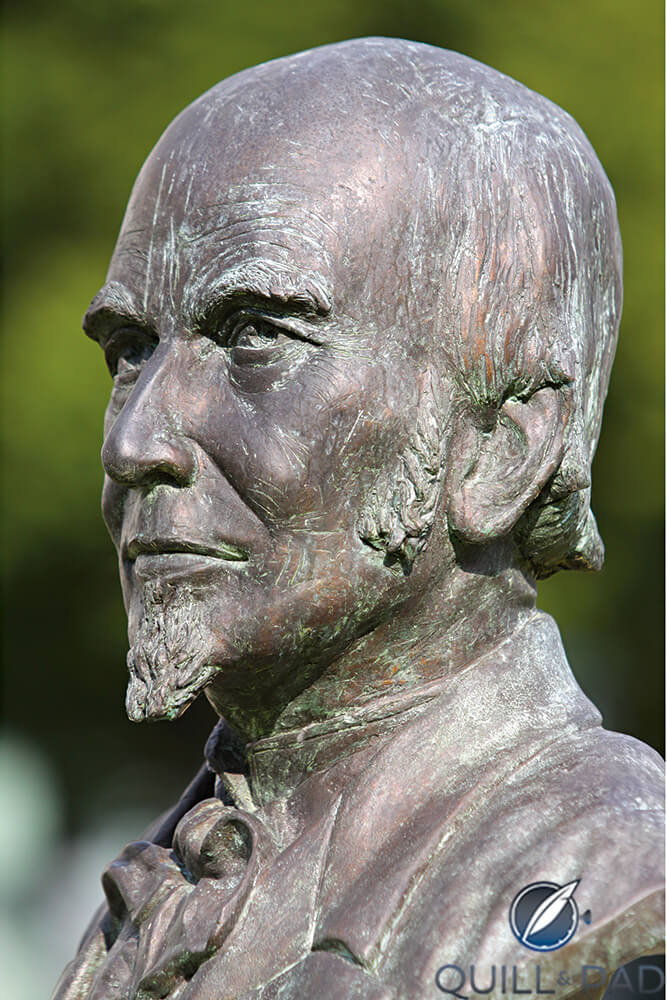
A bust of Ferdinand Adolph Lange in Glashütte
Not only did Lange bring this cache of knowledge back home to Dresden, but he also planted the seed of a concept to start up his own manufacture of pocket watches and the launch of an entire industry.
The area surrounding Dresden was very poor and structurally weak in the 1800s. In the Erzgebirge mountains, silver ore had run out and farmers were finding it hard to make ends meet. Basket weaving was an art that the people had learned to keep their hands busy and at least a few coins coming in.
A generation before F.A. Lange entered the picture, Dresden was a magnificent center for the arts, with August II the Strong, prince elector of Saxony, a powerful supporter. It was during this time that Dresden came to earn the nickname “Florence on the Elbe.”
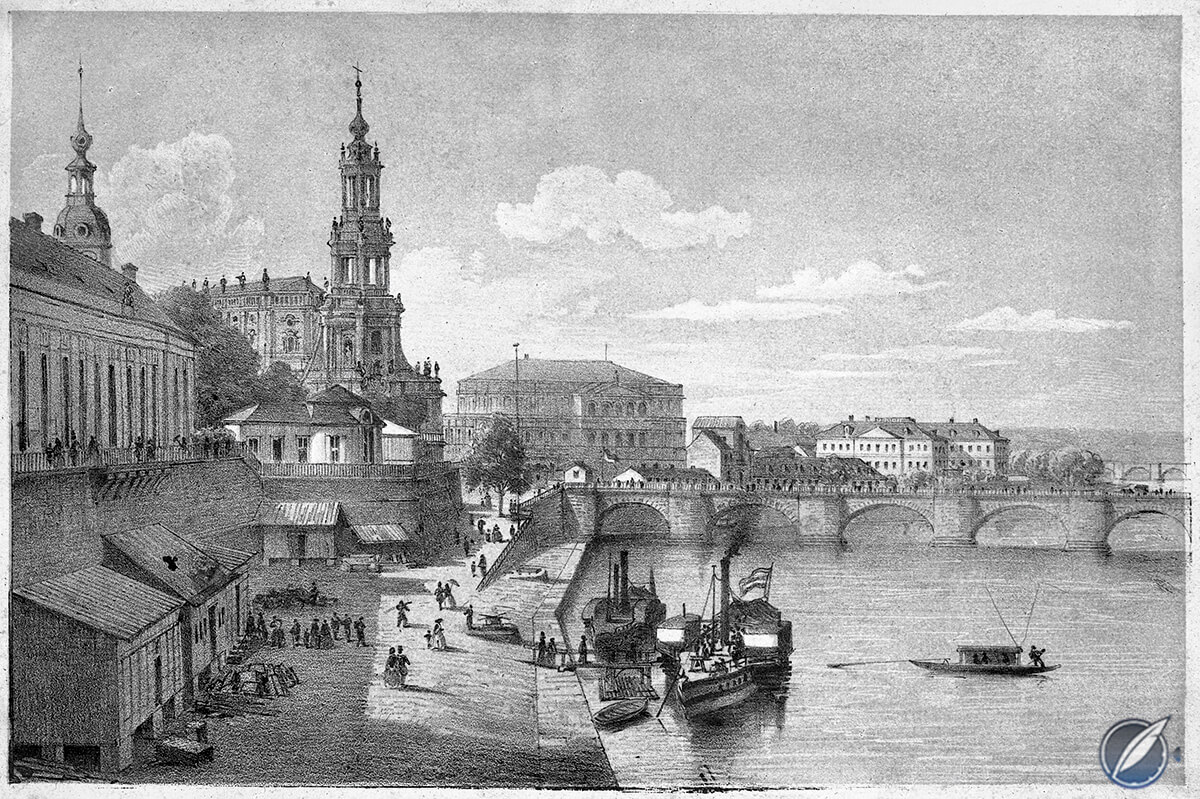
A historic sketch of Dresden’s riverfront area called Brühlsche Terrasse: many historic buildings such as the Semper opera house are clearly visible
This culture is still visible in this incredibly beautiful city today.
While clock- and watchmaking played a role in Saxon life during this time period, there was no real “industry” in the area to speak of, an element that was an intrinsic part of both London and Paris’s horological cultures at the time.
For the German people, being as orderly and time-conscious as they remain to this day, the search for precision and a way to produce more and better watches was an important venture for the government to back.
Upon returning from four years of extensive travels, Lange made it a priority to initiate a new watchmaking industry in Saxony. Submitting a clever concept to the Saxon government, he obtained the support needed to establish a “factory” with the goal of also founding a supplier system. The town he and the government ended up choosing was Glashütte, nestled among the Erzgebirge hills, a poor region in need of aid. The concept called for concentrating on one single pocket watch model.
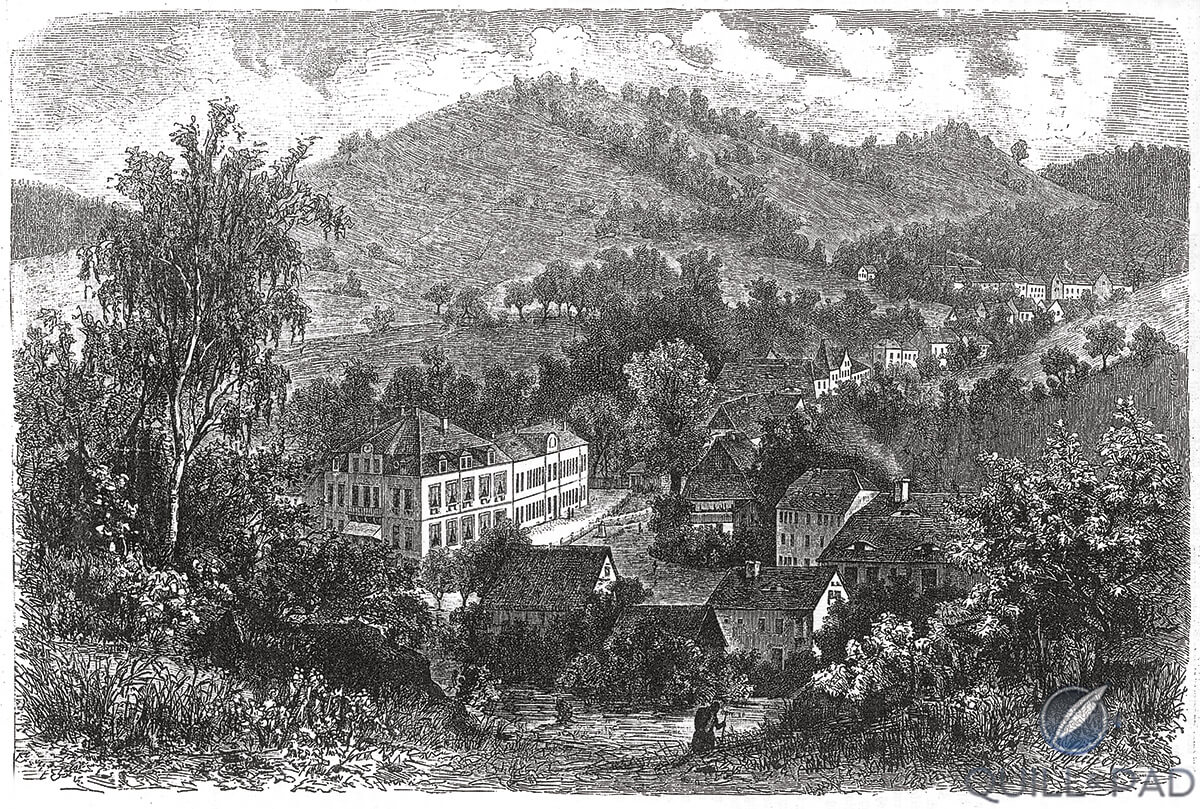
A sketch of Glashütte in 1879
In 1845, Lange founded not only a watchmaking factory that would bear his name; he also established his vision for an entire industry. Starting with a team of 15 basket weavers, he patiently taught them the basics of watchmaking and, once they had thoroughly mastered the crafts they were taught, even encouraged them to leave his company to start their own small supplier firms. Thus, he provided the region with a new means to make a living.
Lange not only established a watchmaking dynasty with his own entrepreneurship, he also exhibited great community spirit: it was obvious that the well-being of Glashütte’s inhabitants and the success of his newly established Saxon watchmaking industry were foremost in his mind.
Thanks to the grand success of Lange’s concept and its implementation, many other pioneering spirits were also attracted to Glashütte. Added to the many suppliers that his progressive system of apprentice training and encouragement helped create, the town roared to life, aided by the founding of Glashütte’s history-making German School of Watchmaking in 1878, a specialized technical school that soon earned a global reputation.
Over the course of the following century, Glashütte became the German center for fine watchmaking, and some of its techniques and procedures – like the uses of the metric system and invar – became standards in horology.
Throughout these hundred years, it was A. Lange & Söhne that waved the flag of luxury watchmaking in the Teutonic regions; the name itself was a sure sign of quality, attracting and inviting various other brands to establish their own factories in the Müglitz River valley.
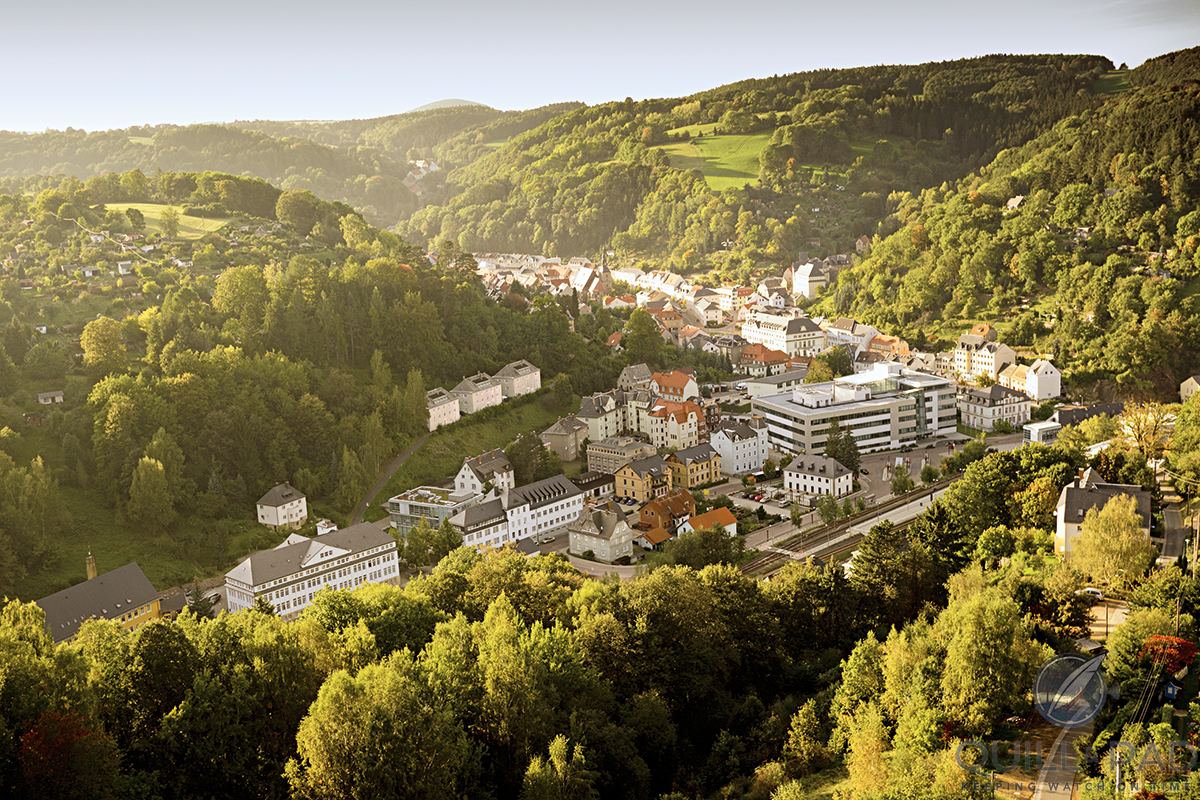
The city of Glashütte (photo courtesy A. Lange & Söhne)
Glashütte in the 1920s and 1930s
If one word could be used to describe Glashütte’s people, then it might be the word “tenacious.” The spirit that continues to prevail in this small city is one of “never say die.”
And this is good so, for the remote region has been afflicted more than once with modern plagues. The next was the world economic crisis culminating in the 1929 market crash, which did its best to dampen Glashütte’s flourishing business with high inflation and a decline in the desire for – or ability to buy – luxury products.
It was during this time that Walter Lange was born in 1924.
“I had a very nice childhood,” Walter Lange reminisced during a conversation we had about ten years ago over coffee and cake, a traditional German meal taken at about 4:00 in the afternoon. The British have their tea time, while the Germans have their coffee time.
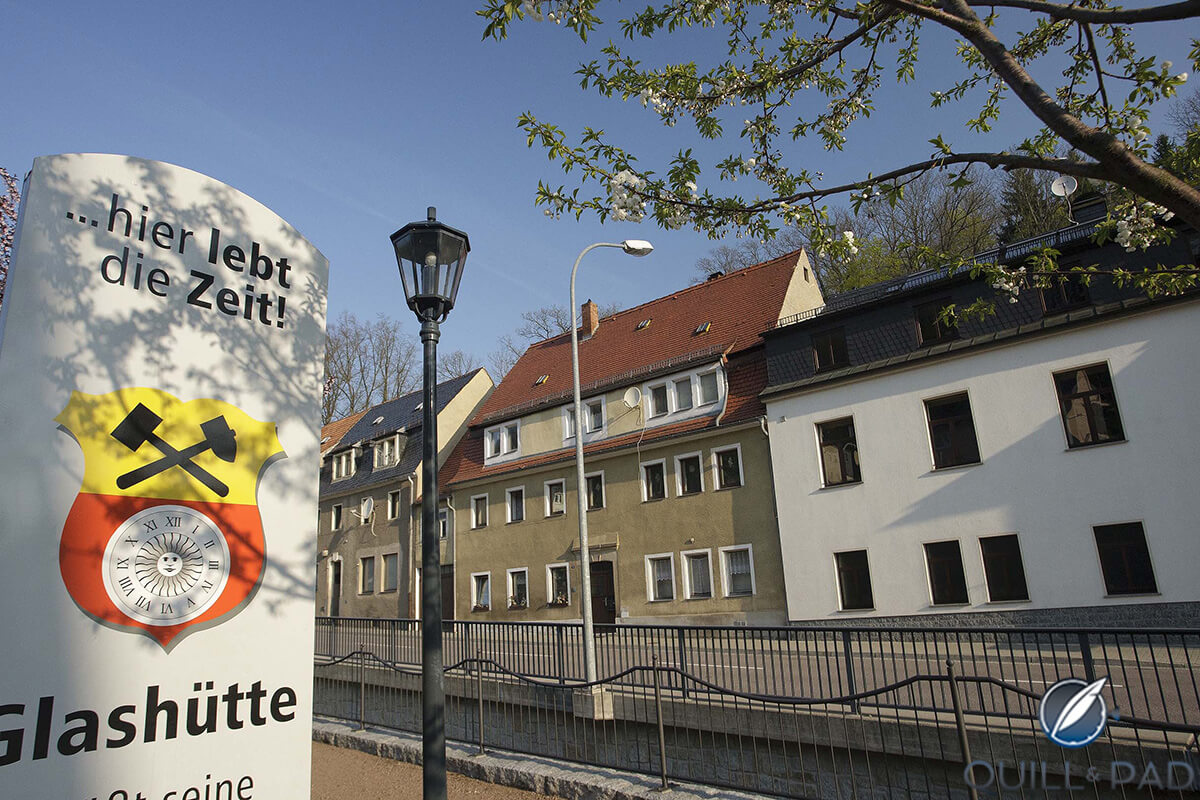
A modern view of Glashütte
“My parents never let on about the status of the times. I was born in the Weimar era; then came the crash in 1929 and the great unemployment. I can still see it today; it was a childhood trauma for me, when I looked out the living room window and saw all the unemployed men lined up, waiting across the street. I will never forget that view, and it was one of the main reasons I started the company again – to bring work to Glashütte. I saw the same situation heading toward Glashütte again.”
As always, Glashütte found the way through that critical stage, beginning all over again with wristwatch production. Once this was successfully underway, the next crisis came knocking, this time one that was almost insurmountable: National Socialism and the rise of the Nazi party.
This bleak period in German history did not leave an isolated region like the Erzgebirge untouched: to the contrary, it was perhaps felt even more strongly there than in a larger city.
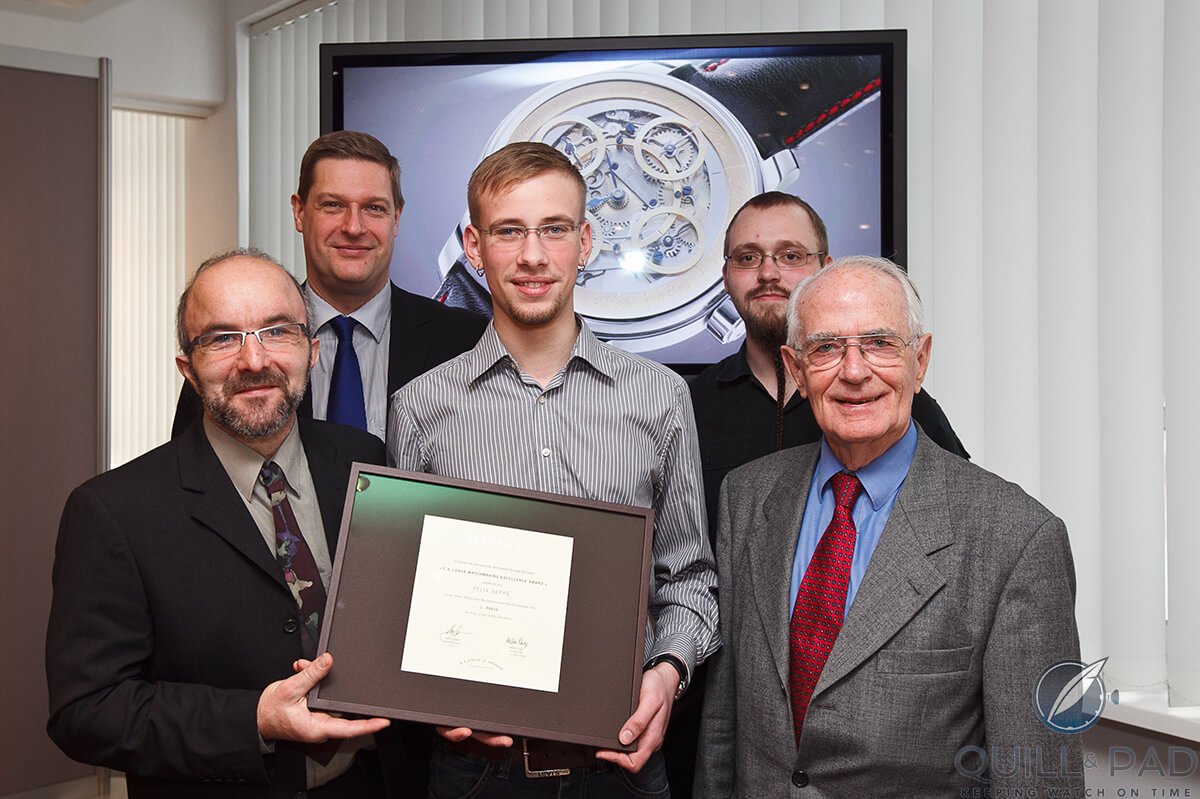
Walter Lange with finalist and winner of A. Lange & Söhne’s young watchmaker competition in 2010
At its high point, Walter Lange was on the verge of becoming a young fourth-generation watchmaker in the family business. At the time he was drafted into the army in 1942 at the age of 18, he had been attending watchmaker school in Karlstein, Austria. Even though Glashütte’s watchmaker school (its historical building is now inhabited by the German Museum of Watchmaking), had the best reputation around, Walter and his family had decided that he should get out and see some of the world.
The perilous 1940s
Little did they know that once the war began, Walter would be soon seeing more of the world than he ever wanted: he was heavily injured at the Russian front before embarking on a perilous journey westward across Denmark in the midst of a retreat to find medical attention.
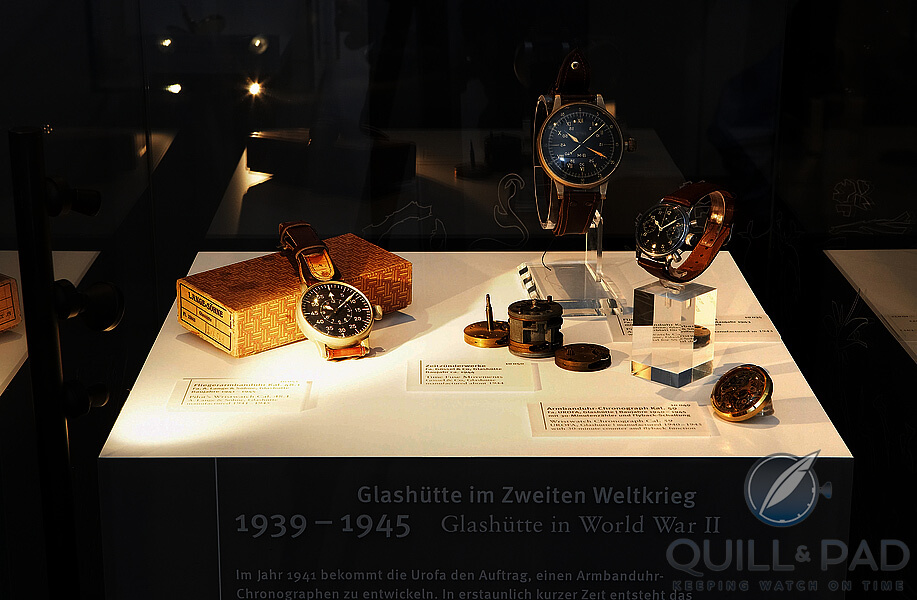
A selection of Glashütte-made pilot’s watches from World War II (photo courtesy Rene Gaens/German Watch Museum Glashütte)
At the same time, A. Lange & Söhne and the other Glashütte watchmakers were forced into manufacturing items for the military, which for them meant developing pilot’s wristwatches for the air force. While the reason for developing these legible, accurate timepieces was perhaps not the most desirable one, these timepieces did become legendary in their precision and reliability, a fact that holds true for all pilot’s watches emerging from Glashütte at this time as well as those from IWC.
Upon returning home from the war, Walter Lange was yet to experience the worst part of this nightmarish chapter in Saxony’s history. Following the end of the war, Germany was divided into four zones, with each of the Allied forces in charge of one: Glashütte was located in the zone belonging to the conquering Russians, who proceeded to pillage and plunder.
Glashütte’s wristwatch technology was apparently one of the aspects that Russia wanted for itself, so the Russian forces obliged A. Lange & Söhne to hand over all construction plans for Caliber 48, the reliable movement used in the pilot’s watches.
Not only that, but the Russian forces even dismantled the factory’s machinery and sent it off to Moscow, leaving Glashütte once again in pitiful shape – and bombed out: Glashütte was the victim of a late air raid that took place on May 8, 1945, just hours before the war was officially declared over. Nothing but an energy-generating turbine was left standing.

Elizabeth Doerr and Walter Lange at the 2010 edition of the Salzburger Festspiele, which A. Lange & Söhne sponsored at the time
Walter Lange returned to his family’s business in 1945 to find it almost non-existent.
But years of diligent rebuilding finally brought it to where it needed to be, and A. Lange & Söhne was once again on the road to its previous global reputation when the next disaster struck: the rise of the German Democratic Republic (East Germany) and the establishment of a planned economy.
In 1948, Walter Lange was condemned to work in the uranium mines – certain death – if he did not agree to join the party and turn his family’s company over to the authorities. This left him no choice but to flee to what was rapidly becoming known as “the West” as joining was not an option for him.
1950s – 1989
Fifty years of East Germany brought big changes to the art of watchmaking Glashütte had once been world-famous for.
By 1951, all the horological companies located in the town were expropriated, thrown together, and combined to form one conglomerate in charge of watchmaking and microelectronics for East Germany.
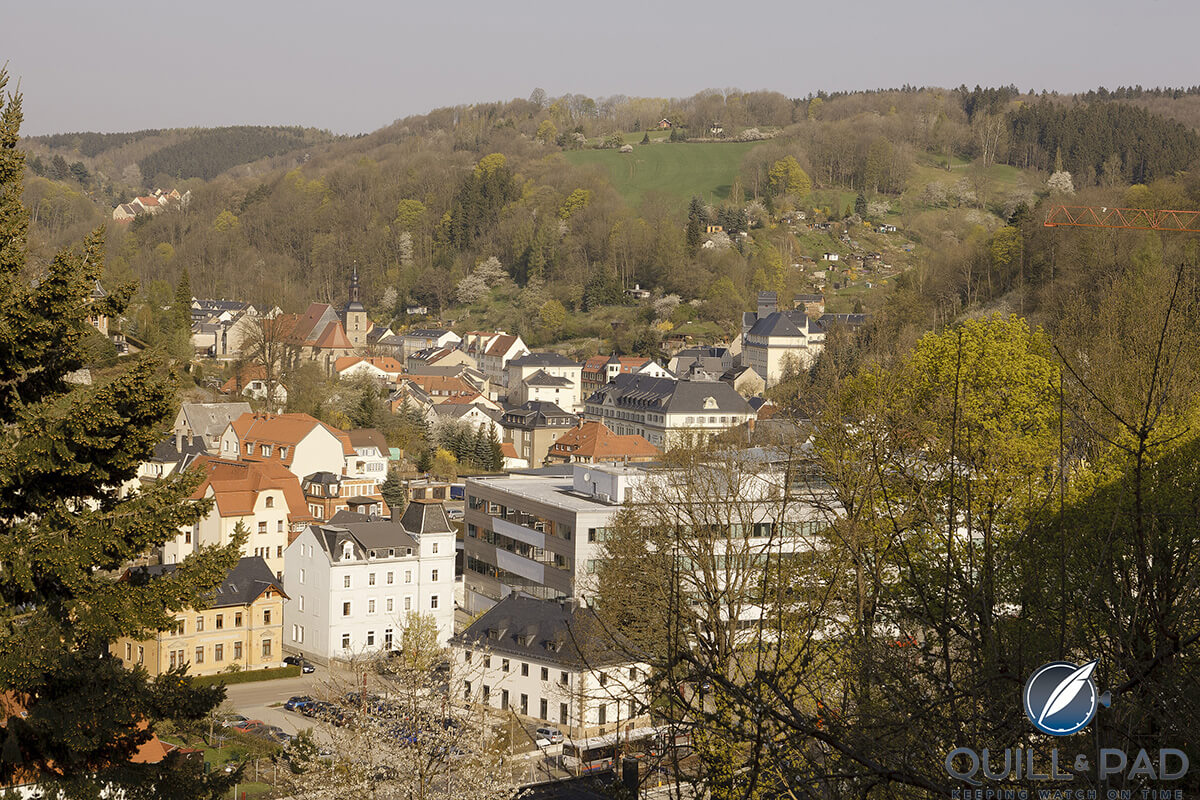
A view of modern Glashütte: the refurbished Glashütter Uhrenbetrieb (Glashütte Original) factory building is the large one at right
VEB Glashütter Uhrenbetrieb, as this “people’s company” was then called, employed about 2,000 people in the 1980s and represented a new way of life for the country’s watchmakers. Mechanical watchmaking in its simplest form was continued, and later the mass-production of quartz watches was added.
Though Glashütte’s horological industry had fallen into a Sleeping Beauty-like sleep, Walter Lange, meanwhile settled in West Germany’s center of watchmaking Pforzheim, never forgot where he came from.
A desire to resurrect his family company continued his to burn within him, though he discovered during the course of fifty years of a changing watchmaking landscape that A. Lange & Söhne was innately connected to the place of its birth and the spirit of its people.
Alone in the West, he could not start over. Therefore, he continued to make a living in his chosen field working for other watch companies.
But he never forgot.
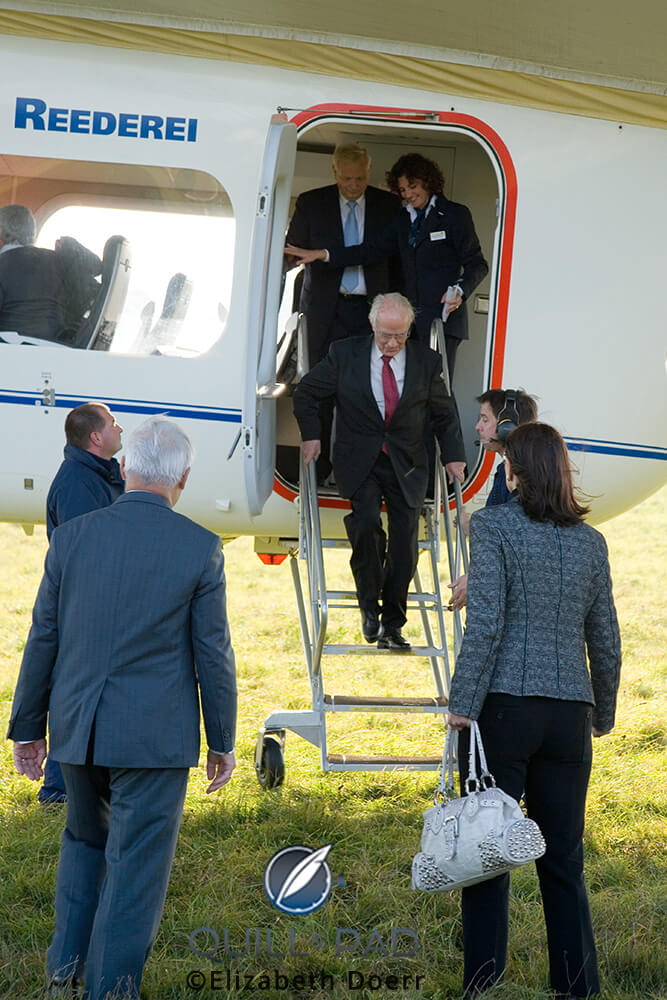
Walter Lange disembarks from a zeppelin during an A. Lange & Söhne event in Dresden in 2006 to introduce the Richard Lange line
Suddenly, magically, in the late 1980s Mikhail Gorbachev was on television. And he was promising a new beginning, an end to a cold war and an iron curtain.
Gorbachev’s Glasnost ideas were to have far-reaching effects, and the inherent cracks in the GDR’s politics suddenly gave way to a flood that spilled over to the Berlin Wall, tearing it to the ground. The German people were reunited; east and west were no longer divided.
And with reunification, Western-style marketability and economics were not to remain far from Glashütte for long.
Importantly, Walter Lange still maintained a burning desire to reinstate his family’s legacy, driven by the memory of a way of manufacturing watches embodying the spirit of an entire region and the know-how of generations of inventive watchmakers for whom making watches was so much more than just making a living.
“This was a pioneering time,” Lange remembers today. “It was such a wonderful time, despite all the difficulties that came along with it. This wasn’t just about re-founding a company, it was about rebuilding Glashütte. My partner in this venture, Günter Blümlein, would often feel he needed to say this to me, ‘Mr. Lange, you are more for Glashütte than Lange.’ For him, it was about the company; for me it was about both. And I take great joy in the fact that today more than 800 people earn their livings with watchmaking in the small city.”
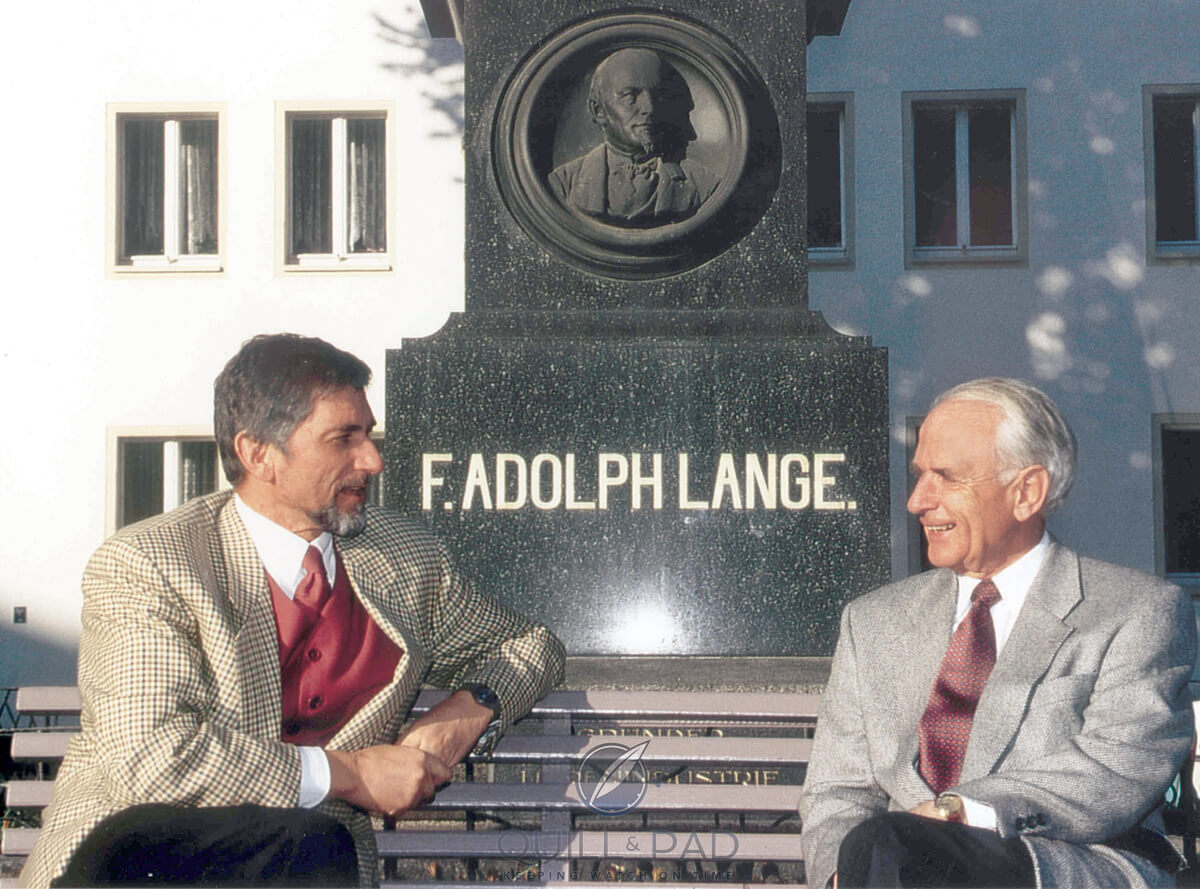
Günter Blümlein and Walter Lange at the F.A. Lange memorial in Glashütte in 1991
Walter Lange said that about ten years ago. Today more than 1,100 people in Glashütte make their livings in the watch industry, more than half of which work for A. Lange & Söhne, the largest employer in Glashütte. At this time, A. Lange & Söhne officially counts 770 employees.
Hurdles, goals, and success
Walter Lange was of retirement age in 1990 when he and Blümlein began the company’s climb back to its former glory; he was 66 years old.
“Blümlein was a genius,” Lange recalled. “He was experienced, accomplished, and he always had ideas. Even the Tourbograph was something that came out of his head.”
Thanks to the initial workforce of 48 people, in 1994 Walter Lange, Günter Blümlein, and Hartmut Knothe were able to unveil four wristwatches of the reborn A. Lange & Söhne to the world: Lange 1, Tourbillon Pour le Mérite, Saxonia, and Arkade.
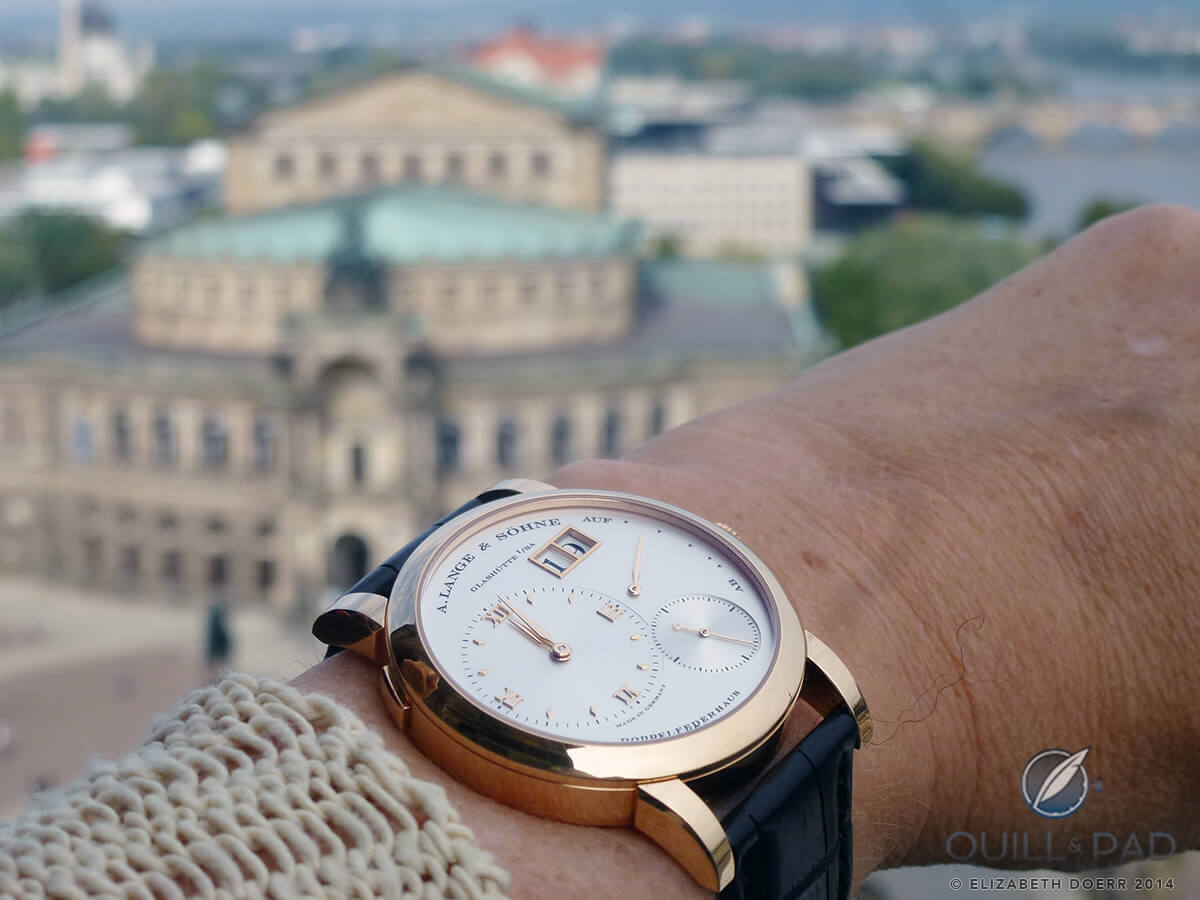
A. Lange & Söhne’s Lange 1 in pink gold against the backdrop of Dresden’s Semper opera house
“It was clear from the beginning that we’d be in the upper price segment and not make some sort of mass-produced product,” Walter Lange remembered. “The real bombshell was the Lange 1. If we’d brought some sort of normal watch with two hands coming out of the center and a second hand, no one would have been talking about Lange. But this crazy new watch from the east was incredible, and everyone wrote about this exotic timepiece, making the name Lange famous again. And with it the name Glashütte. The Lange 1 remains a cult watch, even today.”
After all the success that A. Lange & Söhne has enjoyed in the modern era, it’s hard to imagine the conditions under which Lange and Blümlein had to work to achieve the successful re-establishment of A. Lange & Söhne.
“We had absolutely nothing when we founded the company: no factory building, no employees – the first one was Hartmut Knothe . . . we were as poor as a church mouse, which is hard to imagine today.”
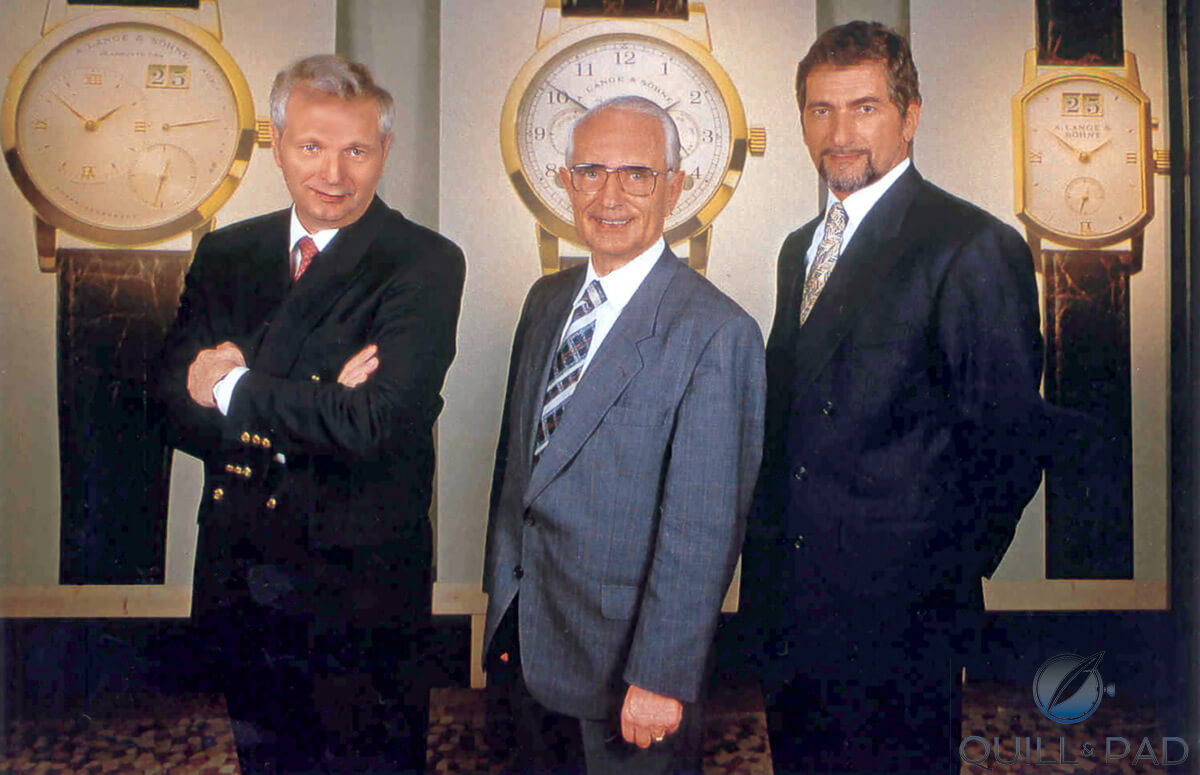
Hartmut Knothe, Walter Lange,and Günter Blümlein at the launch of A. Lange & Söhne in 1994
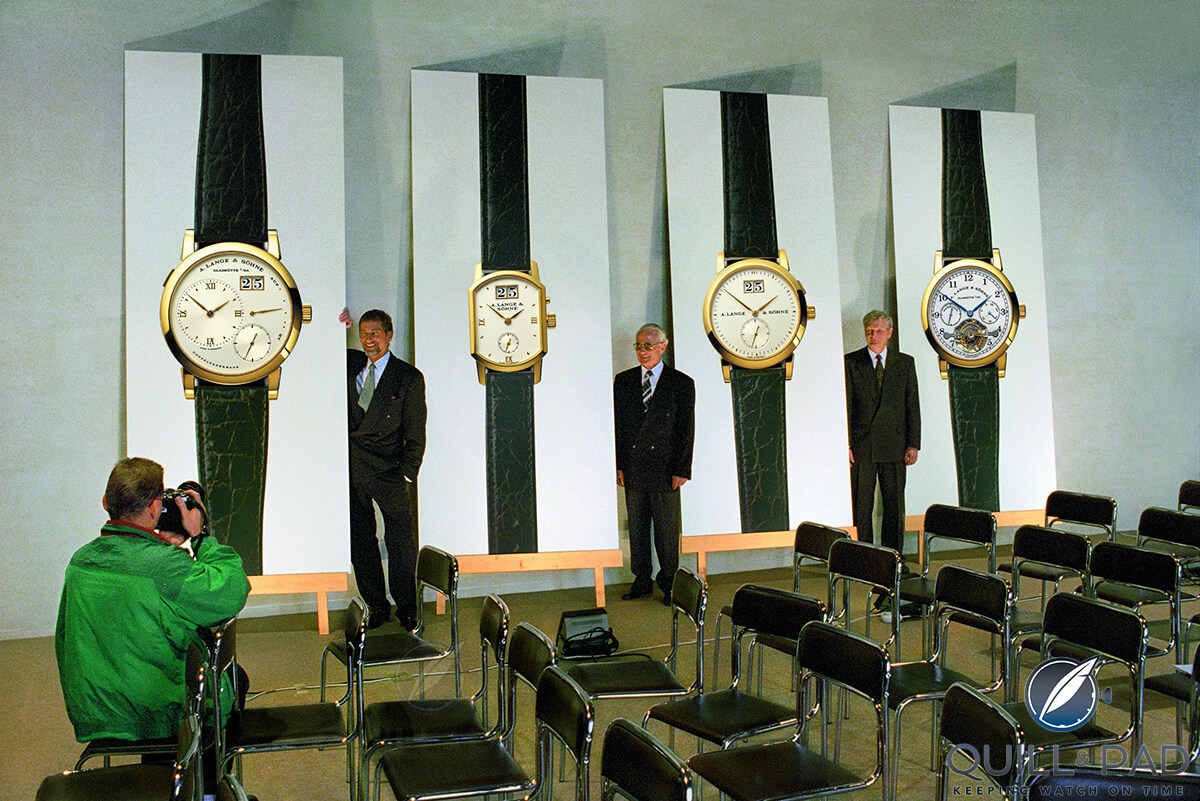
Blümlein, Lange, and Knothe amidst posters of the first four models launched by A. Lange & Söhne on October 24, 1994
The hurdles must have seemed insurmountable at times in this remote valley that time seemed to have forgotten: a dearth of hotels and restaurants as well as poor telephone service and non-existent cell phone service (this remains a problem to this day) only made establishing a business harder.
“When we began in the east, making phone calls wasn’t even possible!” Walter Lange remembered.
In the rest of the world, watchmaking’s mechanical renaissance was just hitting full stride. This was the period to follow the so-called quartz crisis, a decade and a half during which inexpensive Japanese quartz watches almost entirely wiped out the mechanical watch industry in Switzerland and Germany.
In Germany, the mechanical renaissance was undoubtedly accompanied by a resurrection of Glashütte-style watchmaking thanks to Lange and Blümlein.
The hardest blow the pair had to face was obtaining a factory location. Historically, A. Lange & Söhne was headquartered in what is now known as the historic family domain, located at the city’s most prominent crossroads across from the German School of Watchmaking.
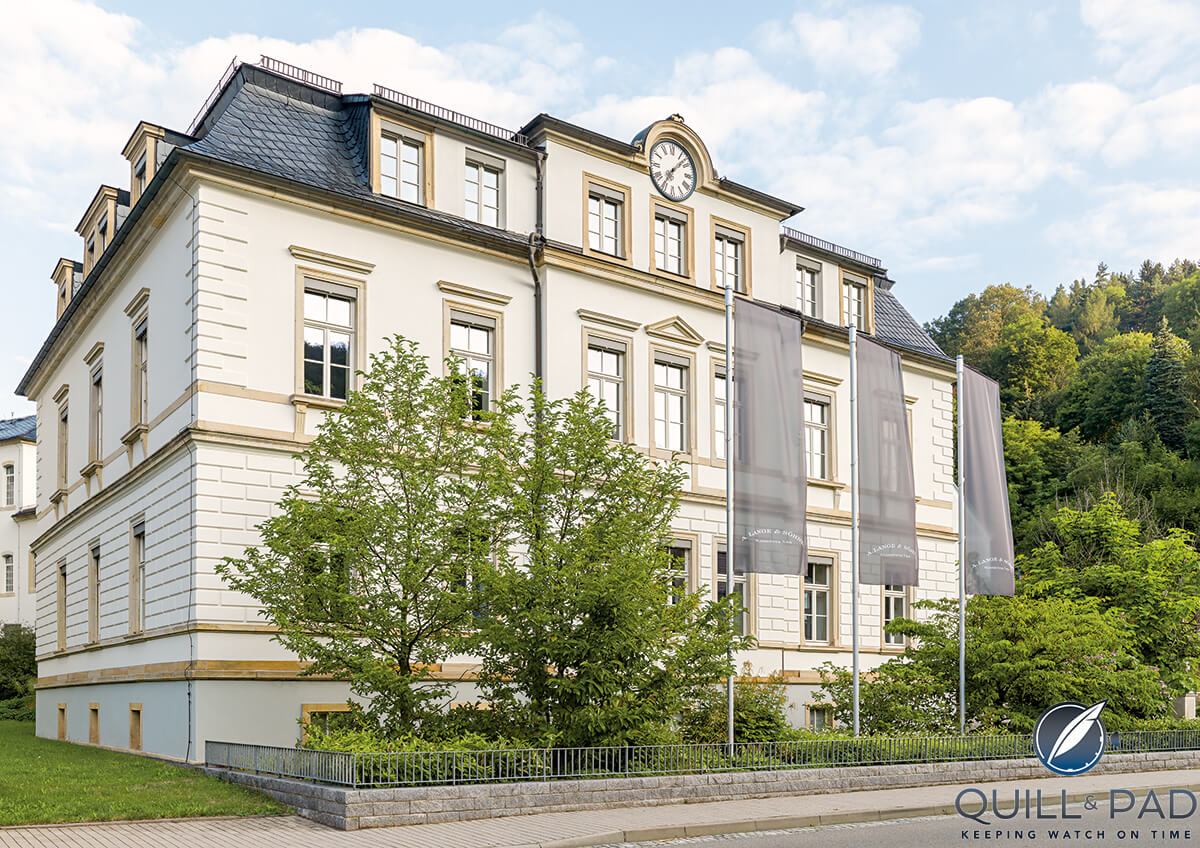
A modern view of the Lange historic family domain where Walter Lange grew up, now the Richemont-owned brand’s headquarters
Logic would dictate that Walter Lange’s childhood home should by rights be given back to him, or at least his company, but a loophole in the German law governing the GDR’s assets did not allow for this. “When the GDR still existed, we were just used to the fact that it was gone. It was much worse after reunification, realizing we wouldn’t be getting it back . . . we had become one Germany again, and the government treasury just swallowed it all.”
Walter Lange literally started over from scratch, with nothing but memories, a burning desire, and a world-renowned reputation.
Lange registered his new company, Lange Uhren GmbH, on December 7, 1990. This date was representative as it was the anniversary of the original founding in 1845. And he registered it using the address of a private residence belonging to an old school friend.
Lange Uhren GmbH was a joint venture between Walter Lange and the watch group known as LMH, managed by Günter Blümlein, which already included the Swiss watch brands Jaeger-LeCoultre and IWC.
“We ended up having to buy the historic family domain back from the government,” Lange told me over our coffee. “That still hurts today when I think about it.” This did not occur until the year 2000.
Additionally, Lange and Blümlein needed to find people to work in the factory, so they hung signs in the gargantuan GUB building located next door to A. Lange & Söhne’s historic family domain, though this Goliath was also undergoing changes due to German reunification that turned it into more of a David: between 1990 and 1994 the workforce was pared down from 2,000 to 70 people.
Many of the employees were still hoping against hope for a solution at the time, and it wasn’t easy to convince the watchmakers to run to “the other side.” The professional home of two generations of Glashütte watchmakers, GUB’s workers often viewed “western” entrepreneurship as “an enemy of the working class.”
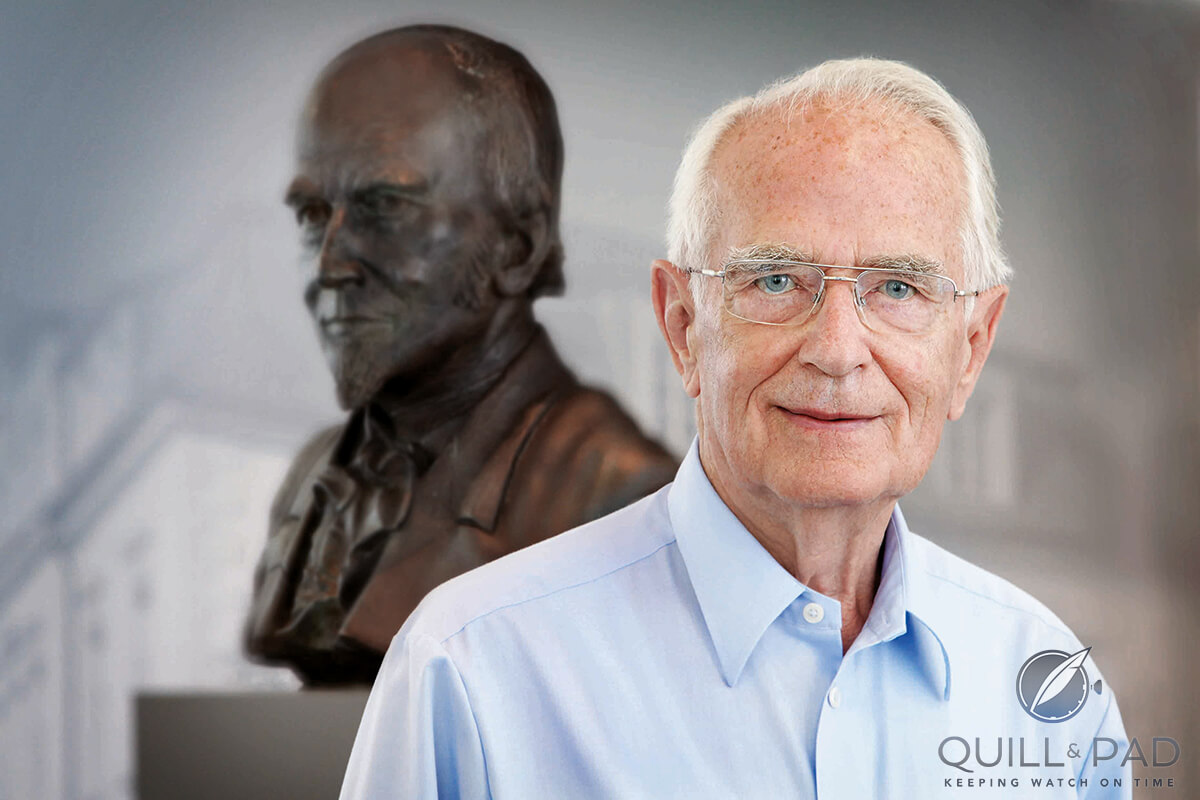
A sprightly Walter Lange as he turned 90 years old in 2014
Finally, applications began to come in, many from watchmakers whose grandfathers had worked for A. Lange & Söhne. Gathering a small workforce was not easy, but it was eventually accomplished, thanks in great part to local expert Hartmut Knothe, who became one of Lange Uhren GmbH’s managing directors. “Knothe was so good, he knew everyone, and he managed the entire setup in Glashütte,” Walter Lange praised.
Then Blümlein and Lange had to figure out a good way to re-train them, as two generations of simplified watchmaking had curtailed the chain of knowledge of high watchmaking, though much had been handed down behind closed doors.
A. Lange & Söhne’s new watchmakers were sent to Switzerland – IWC, to be exact – to become familiarized with the modern watchmaking technology necessary to create haute horlogerie.
I know Walter Lange was more than proud of initiating this resurgence, but it wasn’t pride that drove him to do it. It was love of his craft, respect for his family, and appreciation for Glashütte’s people.
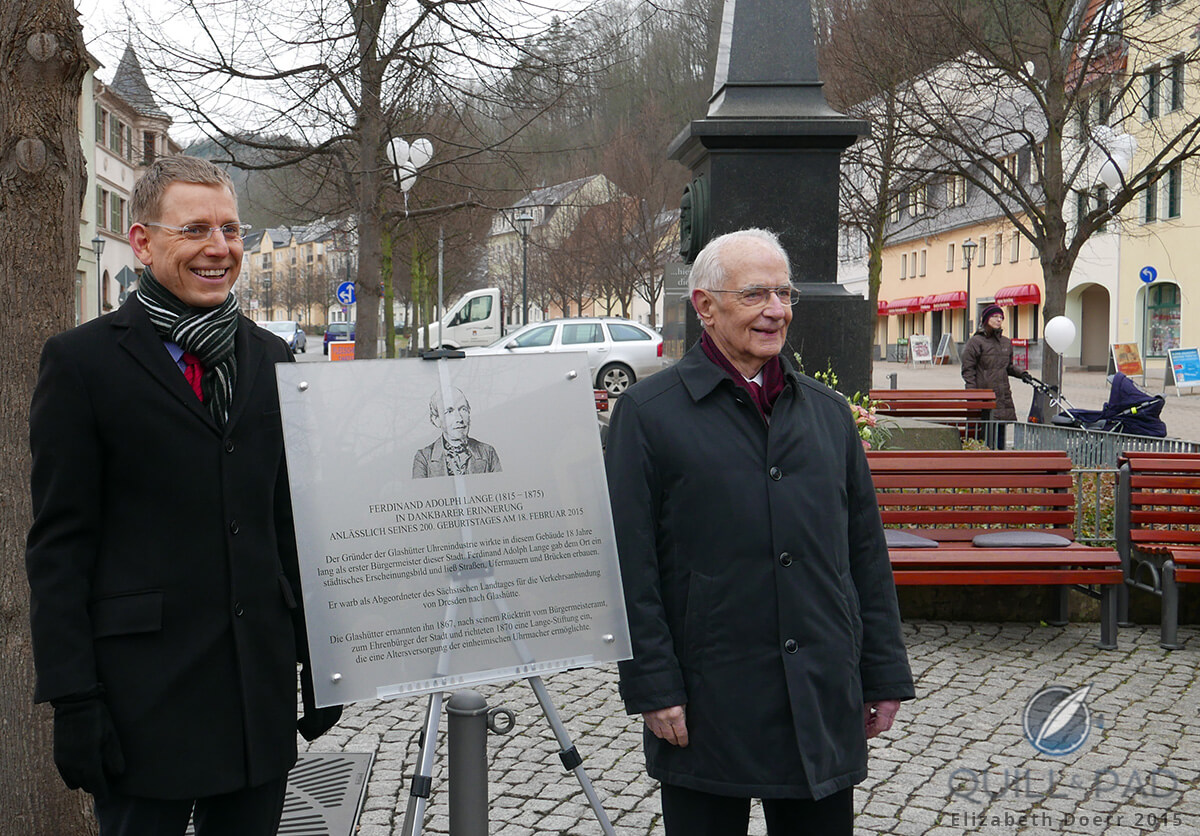
Glashütte Mayor Markus Dressler (left) and Walter Lange unveiled a new plaque commemorating the 200th anniversary of Ferdinand Adolph Lange’s birthday in 2015
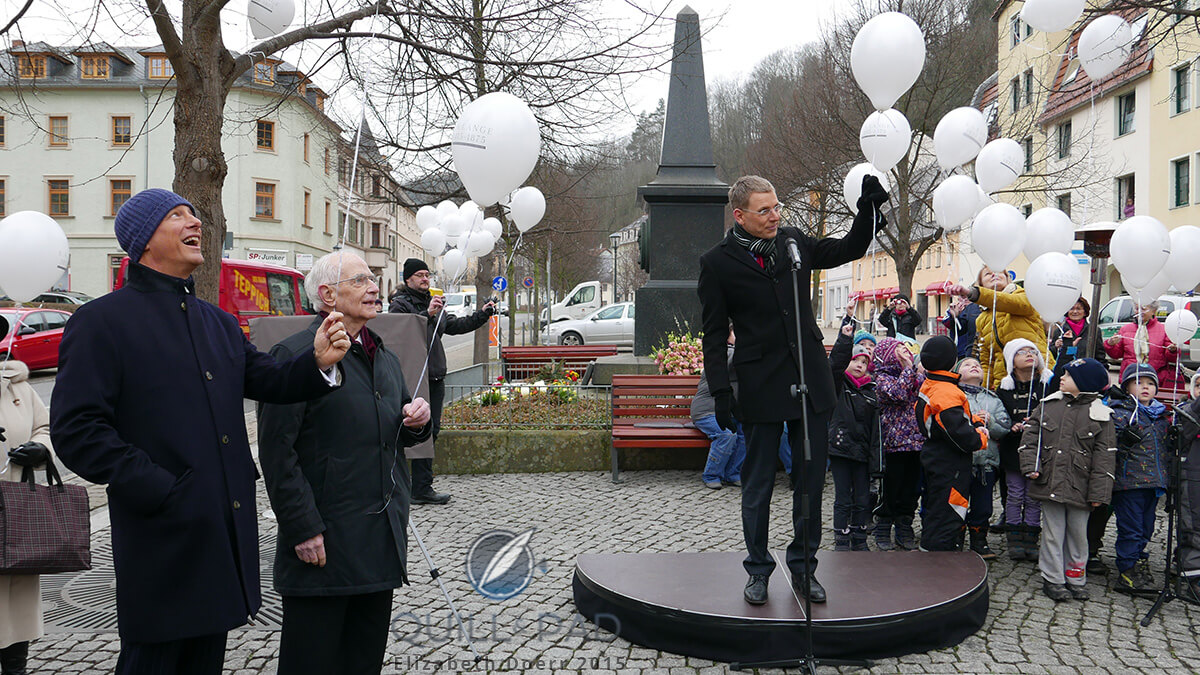
A. Lange & Söhne CEO Wilhelm Schmid, Walter Lange, and Glashütte mayor Markus Dressler sent off 200 balloons in Ferdinand Adolph Lange’s memory along with townspeople and guests on February 18, 2015
“I did this for Glashütte and for the company; I wanted to see it flourish. An important point for me was to bring work back to Glashütte,” he confirmed his motivation in beginning all over again at the age of 66. “I wasn’t thinking of making money at all. I was already too old for that.”
Since 2001
In 2001, LMH – which started out as a division of VDO/Mannesmann – ended up in the possession of Compagnie Financière Richemont SA, where it now resides with a variety of other famous watch brands, including Cartier and Vacheron Constantin, and high fashion brands like Chloé.
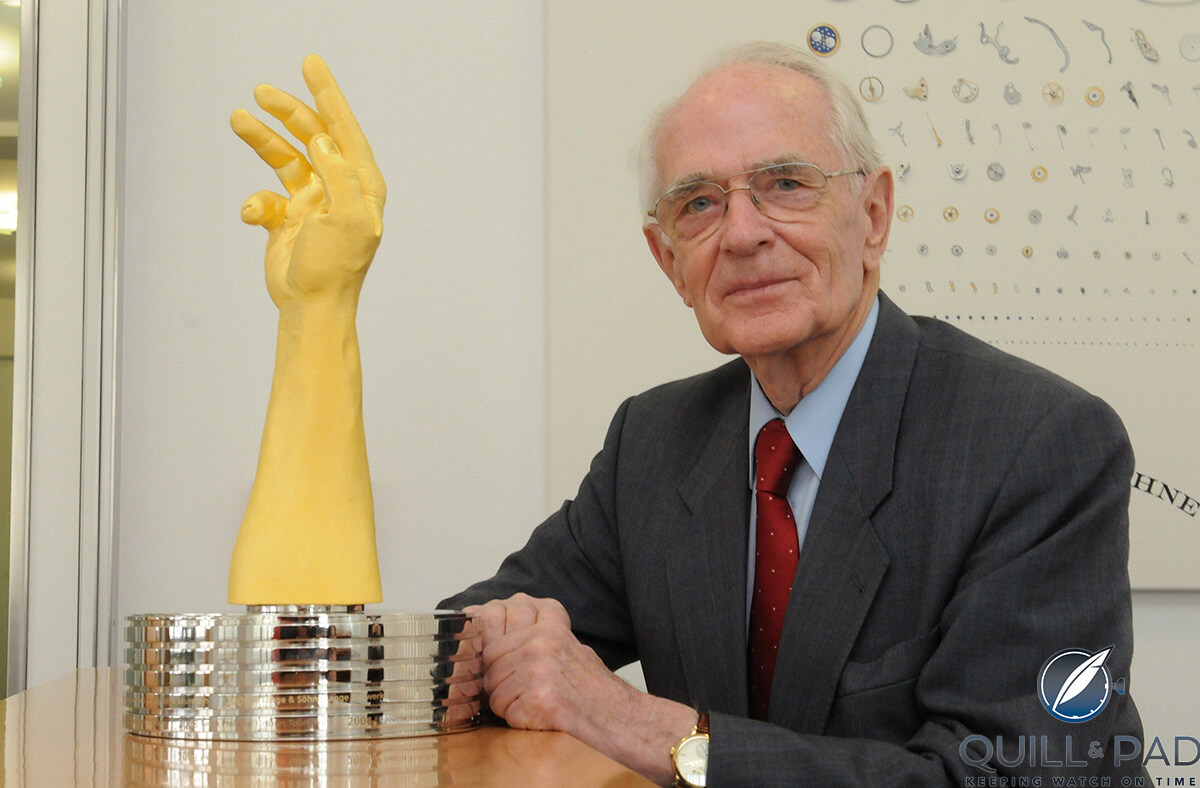
Walter Lange poses with the striking trophy of the Grand Prix d’Horlogerie de Genève
In the same year, and at the age of 58, Blümlein – who was honored by the German president in 1997 for being a “courageous entrepreneur that our country needs” – passed away; Walter’s wife, Jutta Lange, followed in 2002.
Yet I never once heard this man complain about anything in life. Instead, he continued to serve the company that bore his name as its figurehead, fulfilling the important task of instilling passion and a link to history in its many employees and passionate fans.

Walter Lange on stage at the 2014 Grand Prix d’Horlogerie de Genève accepting the Special Jury Prize for his life’s work
“You can work as hard as you want, but if you don’t have just a little bit of luck, it will never work out for you,” Walter Lange often said. And I believed him every time he said it.
Today A. Lange & Söhne can count more than 250 international awards for the product and design quality of its watches, including a total of seven from the Grand Prix d’Horlogerie de Genève.
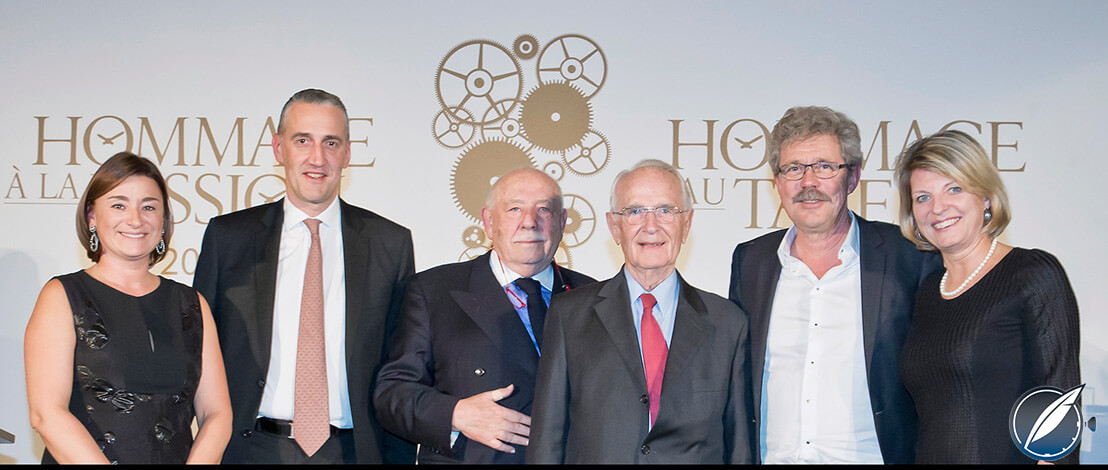
FHH Homage a la Passion 2013: (l to r): Fabienne Lupo (FHH), Olivier Baudry (director Julius Baer, Geneva), Franco Cologni (FHH), Walter Lange, Jean-Marc Wiederrecht, Catherine Wiederrecht
These seven GPHG prizes are as follows: Calendar Watch Prize for Richard Lange Perpetual Calendar Terraluna (2014); Special Jury Prize for Walter Lange (2014); Grande Complication Prize and Public Prize for 1815 Rattrapante Perpetual Calendar (2013); Aiguille d’Or for the Lange Zeitwerk (2009); Special Jury Prize for Tourbograph Pour le Mérite (2006); and Special Jury Prize for Lange Double Split (2004).
Additionally, Walter Lange won the 2013 FHH Homage à la Passion prize. See more about that at A. Lange & Söhne’s Lange And Watchmaker Wiederrecht Win ‘Passion’ And ‘Talent’ Watch Awards.

Walter Lange received Saxony’s Order of Merit in 1998
Though it is most likely 1998’s Order of Merit from the State of Saxony and 2015’s Order of Merit from the Federal Republic of Germany that he was most pleased about.
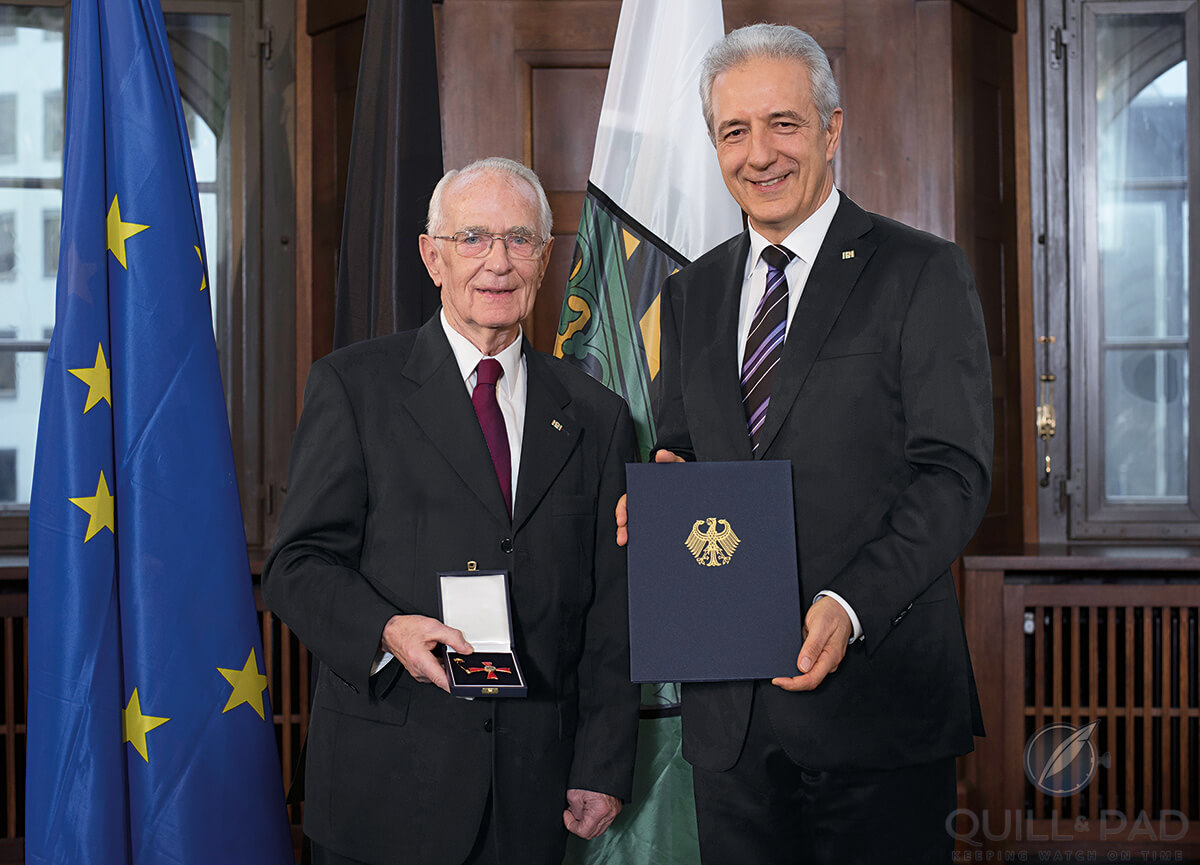
Walter Lange received the Order of Merit from the Federal Republic of Germany in 2015
January 27, 2017
A week after his death, Walter Lange was laid to rest on an ice-cold, yet sunny day in Glashütte.
In addition to a large number of visitors paying respects from outside the area – one couple came all the way from Japan – the entire town turned out; residents lined the streets to watch the funeral procession from St. Wolfgang’s church to the town cemetery, the place where many famous historical watchmakers are buried. Walter Lange was placed in the family crypt alongside his famous ancestors, the founders and perpetuators of the Glashütte watch industry.
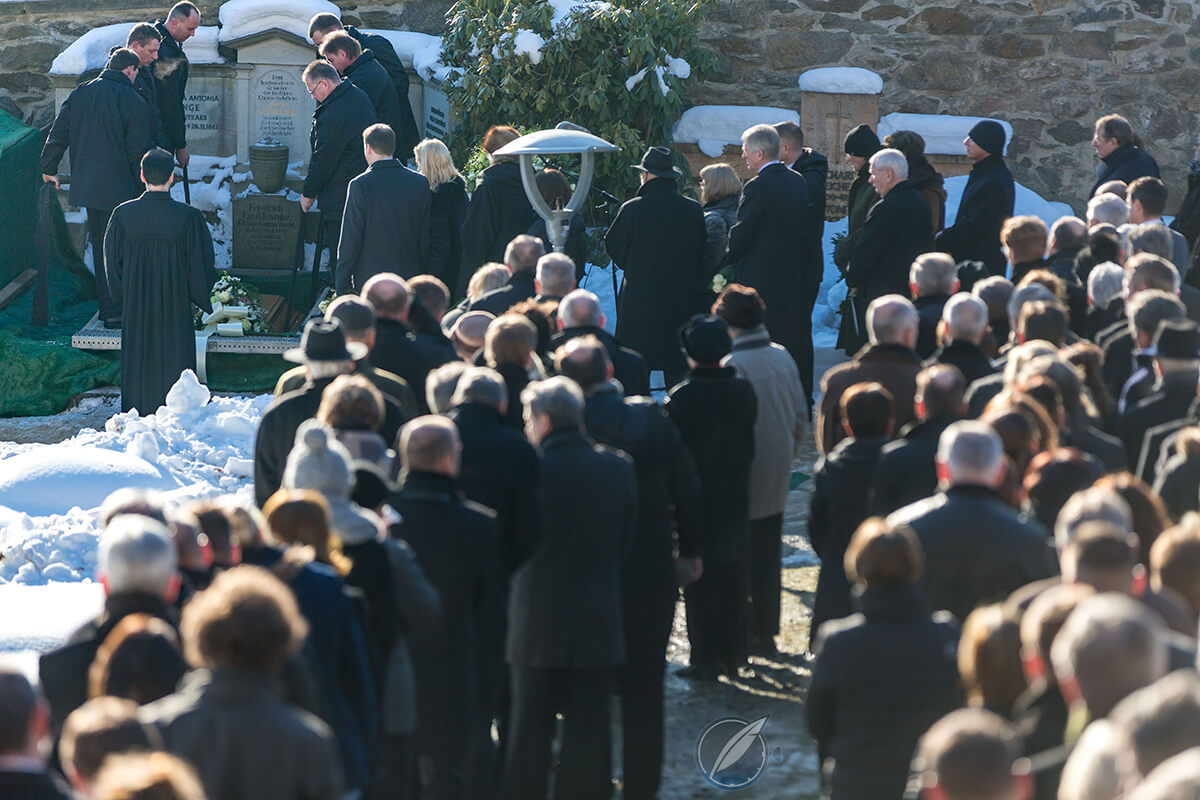
Well wishers paying their respects at the funeral of Walter Lange in Glashütte on January 27, 2017
I was so amazed to see that there were truly no dry eyes anywhere. Colleagues, competitors, people he likely argued with on a daily basis, loved ones, family, and admirers . . . all of them were equally struck by, and expressed, the magnificent quality of his life and work.
Walter Lange continues to be the kind of person that has people rallying around him and inspiring greatness, and that is comforting. He is a shining example of the best kind of passion there is in watchmaking: the true kind with not even a trace of artifice or greed.
He will not be forgotten any time soon.
You may also enjoy:
Lange & Söhne Looks Back On 20 Years Of The Lange 1 And 25 Years Of German Reunification: Film Premiere
How The Wall Came Tumbling Down: Made In Germany
The Tutima Hommage Minute Repeater Chimes ‘Happy To Be Home’
Happy 90th Birthday To Walter Lange With A Look Back At The Modern A. Lange & Söhne
Trackbacks & Pingbacks
-
[…] With the foundation stone laid for the new Lange manufactory, the founder’s great-grandson, the late Walter Lange, also a watchmaker, ushered Glashütte into a new era. “We didn’t have much at that point,” Walter Lange once reminisced. “We had no watches that we could build and sell; we had no employees, no building, and no machines. All we had was the vision of once again crafting the world’s best watches in Glashütte.” (For more on Walter Lange, see The Life And Times Of A. Lange & Söhne Re-Founder Walter Lange.) […]
-
[…] The Life And Times Of A. Lange & Söhne Re-Founder Walter Lange, published in January 2017, you will know how much I felt this man had contributed to high-end […]
-
[…] a year where Glashütte’s history had suffered a major loss with the passing of Walter Lange (see The Life And Times Of A. Lange & Söhne Re-Founder Walter Lange), I was profoundly glad to find this piece of Glashütte history so beautifully and lovingly […]
-
[…] the mid-1990s Bertini and Blümlein – Walter Lange’s partner in re-founding A. Lange & Söhne and head of LMH (Les Manufactures Horlogères), which […]
-
[…] With the foundation stone laid for the new Lange manufactory, the founder’s great-grandson, the late Walter Lange, also a watchmaker, ushered Glashütte into a new era. “We didn’t have much at that point,” Walter Lange once reminisced. “We had no watches that we could build and sell; we had no employees, no building, and no machines. All we had was the vision of once again crafting the world’s best watches in Glashütte.” (For more on Walter Lange, see The Life And Times Of A. Lange & Söhne Re-Founder Walter Lange.) […]
-
[…] Lange & Söhne’s resurrection (for the full story see The Life And Times Of A. Lange & Söhne Re-Founder Walter Lange) caused a flood of interest in both mechanical watches and German watches, particularly in […]
-
[…] 30 years of age, that Struthers got into watchmaking at all was a stroke of luck – but then, as Walter Lange always said, without that little pinch of luck, nothing really ever […]
-
[…] And in the case of the A. Lange & Söhne Pour le Mérite Tourbillon, what people! The PLM story, of course, starts with Günter Blümlein and Walter Lange, who worked together at the time of the fall of the Berlin Wall to revive fine German watchmaking under the Lange brand (see The Life And Times Of A. Lange & Söhne Re-Founder Walter Lange). […]
Leave a Reply
Want to join the discussion?Feel free to contribute!



Thank you, Elizabeth!
More than my pleasure, Carlos. This man deserves so much more than a long story written about him . . .
Thank you for an interesting and well-written story about a remarkable person. It becomes obvious that true authenticity creates an authentic and genuine history and likewise products.
Thank you for reading! It’s so obvious, actually, and so many brands could learn by example. Nothing, and I mean nothing, beats authenticity when it comes to this.
Thank you Elizaneth for writing this article about Mr Lange’s life.
I must admit I joined the ranks with ” no dry eyes” during the last paragraph.
Great read! Thanks, Beth!
My pleasure, Christian.
Fantastic article, Elizabeth.
Exactly the sort of content I visit QaP for.
Wonderful article and history of AL&S and Mr W Lange.
Mr Walter Lange’s vision will be sadly missed!
Thank you very much, Roman. And he will be very missed!
Elizabeth: what a great article on Walter Lange. Few people in the world experienced such devastating losses – to his family business, his legacy, fighting the government, etc. Then, to say that they were going to literally start over yet again and start making world-class watches was no small feat. As I learn more about this amazing family, I am simply blown away at their fortitude, wisdom and enduring strength. The ALS watch was virtually unknown to me until a year ago. I saw “Glashutte” and figured it was a Glashutte watch – which I always really liked. Then, I discovered ALS, and consider them the best in the world, and to make such a leap in so short of time is amazing. Thank you for this beautiful article.
Thank you so very much for reading this and understanding all the sentiments so perfectly! Walter and the entire Lange family were (and are) extraordinary people. And the watches are certainly among the best in the world!
I agree: “few people in the world experienced such devastating losses” as he
inflicted on the Russian people during World War II. Were the Langes nazis?
You have got to be kidding. Read Walter Lange’s autobiography.
This is such a living, breathing, loving, thinking, dreaming, talking, and catching text about Lange & Söhne – it is a pleasure to read. It takes me on a journey through the fascinating live of W. Lange and the ALS watchmaking company. Reading your “The Life And Times …” opens up images like being in a movie or watching a documentary about Herrn Lange (and his friends and partners), the company, and the Glashütte region inside my head. The silence of a written text is much nicer compared to a noisy documentary or even a modern YouTube-Video; and this silence fits much better to the passion of watches and watchmaking. Roughly 30 years have passed to bring this company to its peak position in mechanical watchmaking 2020. This is very short. But if you extend the success of the company to the whole life of Walter Lange and to all the energy of the up- and down-moments in this life … you better understand the soul of ALS.
Ich habe den Text ursprünglich gelesen, um noch mehr freaky Details über die Armbanduhren von Lange & Söhne zu erfahren. Und jetzt denke ich mir gerade „Was ein Quatsch die Jagd nach den vielen Kleinigkeiten doch ist“. Wenn man in eine Geschichte unerwartet einfach so hineinfällt und sich zum Nachdenken lange Zeit nimmt, erfährt man viel mehr. This is a serious invitation to forget about reference-numbers, movements, case materials, production numbers and auction results.
Danke, dass Sie meine Faszination auch teilen. Diese Firma ist unglaublich reich an Tradition, Seele, Kultur und Liebe zum Detail. Walter Lange hat für mich dies alles verkörpert. Schön, dass das in seiner Arbeit auf ewig weiter lebt.
I’ve been interested
in the watchmaking industry since I worked for the UK Division of IWC & Jaeger-lecoultre from 1989-1993 and was honoured to meet Gunter Blumllein twice. It was during this time that GB, together with Walter Lange were attempting to resurrect the once-great A.Lange & Son, and didn’t they do well. I’d always revered IWC & JLC watches, and then in 1994 came the first new Lange watches, and weren’t they beautiful. I knew nothing about Walter Lange at the time, but have read an awful lot about him since, and his company’s history and the city of Glashutte with all its recent troubled times. Walter Lange was an obvious genius who never lost his ambition to revive one of the world’s most prestigious watch manufacturers. This he finally succeeded with Gunter Blumllein and others.